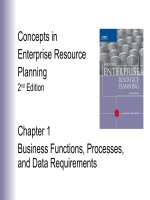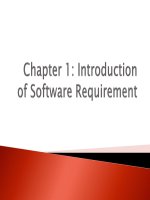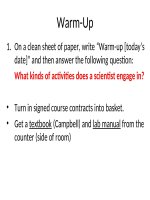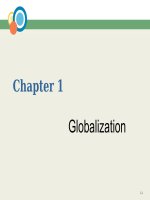Lecture Communication skill: Chapter 1 - Tracey Bretag, Joanna Crossman, Sarbari Bordia
Bạn đang xem bản rút gọn của tài liệu. Xem và tải ngay bản đầy đủ của tài liệu tại đây (268.8 KB, 39 trang )
Chapter 1
Effective reading for
academic purposes
Copyright 2009 McGraw-Hill Australia Pty Ltd
PPTs t/a Communication Skills, by Bretag, Crossman and Bordia
1
1-1
Learning objectives
On completion of this chapter students will
know how to:
• identify individual reading styles and
recognise their strengths and weaknesses
• understand the role of critical reading in the
Australian academic context
• develop a range of strategies to improve
reading capability, including speed and
comprehension
Copyright 2009 McGraw-Hill Australia Pty Ltd
PPTs t/a Communication Skills, by Bretag, Crossman and Bordia
2
1-2
Learning objectives (cont.)
• adapt reading styles to suit the requirements
of different texts
• recognise the integrated nature of reading
and note-taking.
Copyright 2009 McGraw-Hill Australia Pty Ltd
PPTs t/a Communication Skills, by Bretag, Crossman and Bordia
3
1-3
Why focus on reading?
• Tertiary studies require you to read very
widely and in-depth across a range of
subject areas.
• You will encounter new vocabulary and
concepts.
• You will begin to notice that writers use
different styles and structures of writing
depending on the subject area.
• You might find that the reading strategies
you have been using successfully are no
longer adequate.
Copyright 2009 McGraw-Hill Australia Pty Ltd
PPTs t/a Communication Skills, by Bretag, Crossman and Bordia
4
1-4
Your own reading style
• In groups of three or four, discuss your own
reading ability.
–
–
–
–
What makes a ‘good’ reader?
Are you a good reader?
What is your main problem when reading?
What strategies have you developed for reading?
Copyright 2009 McGraw-Hill Australia Pty Ltd
PPTs t/a Communication Skills, by Bretag, Crossman and Bordia
5
1-5
Your own reading style
(cont.)
• Also consider the following questions:
– What sorts of reading material do you enjoy
most? Why?
– What attracts you to start reading a book or other
text (e.g. cover, pictures, font size, topic etc.)?
– What are the best conditions for your reading?
– Do you use the same place?
– Do you need to be alone?
– Do you read at the same time each day?
Copyright 2009 McGraw-Hill Australia Pty Ltd
PPTs t/a Communication Skills, by Bretag, Crossman and Bordia
6
1-6
Reading (English) quiz
For each of the following items, indicate whether the
statement is true or false.
1. I never read (in English) for pleasure.
True False
2. Reading is a tedious task that I do only because I
have to.
True False
3. The best way to read academic texts is to just read
the abstract or summary and then pretend to have
read the whole thing.
True False
Copyright 2009 McGraw-Hill Australia Pty Ltd
PPTs t/a Communication Skills, by Bretag, Crossman and Bordia
7
1-7
Reading (English) quiz
(cont.)
4.
A good strategy to understand difficult vocabulary is to
use an electronic translator.
True False
5.
If I could read faster I would be a ‘good’ reader.
True False
6.
I know I can’t read all the material assigned to me in
my program, so I don’t even try.
True False
7.
I have some well-developed reading strategies which
have worked very well in my study experience to date.
True False
Copyright 2009 McGraw-Hill Australia Pty Ltd
PPTs t/a Communication Skills, by Bretag, Crossman and Bordia
8
1-8
Reading (English) quiz
(cont.)
8.
I find that talking about the main points of a difficult text
with a classmate really helps my comprehension.
True False
9.
I never write notes as I read. I just keep the information
in my head.
True False
10. I always use a highlighter or pencil when reading
academic texts.
True False
Copyright 2009 McGraw-Hill Australia Pty Ltd
PPTs t/a Communication Skills, by Bretag, Crossman and Bordia
9
1-9
Critical reading
• Students need to take individual
responsibility for learning.
• Much more reading is needed than just the
lecture notes or course guide.
• Developing your reading skills is of
paramount importance.
Copyright 2009 McGraw-Hill Australia Pty Ltd
PPTs t/a Communication Skills, by Bretag, Crossman and Bordia
10
1-10
Critical reading (cont.)
• ‘…it is not simply what you read or how
much you read but how you read that will
crucially affect your level of reading skill’
(Boddington and Clanchy 1999, p. 1).
• How you read will impact on your
understanding of source material and the
way you incorporate these sources into your
own writing on a topic.
Copyright 2009 McGraw-Hill Australia Pty Ltd
PPTs t/a Communication Skills, by Bretag, Crossman and Bordia
11
1-11
Critical reading (cont.)
• Critical reading involves making judgments
about the value of what you are reading
(Boddington & Clanchy 1999).
• Instead of simply consuming information you
are expected to become a producer of
information.
• You need to carefully assess what you read
while constantly asking yourself whether the
information you are reading is useful for the
particular assignment you are working on.
Copyright 2009 McGraw-Hill Australia Pty Ltd
PPTs t/a Communication Skills, by Bretag, Crossman and Bordia
12
1-12
Critical reading (cont.)
• To develop critical thinking and reading you
need to interrogate both the writer and the
text. Use the following questions to help you
gain a critical perspective:
– What is this document about?
– Is it accurate? How do you know?
– Who wrote it? Is the writer an authority in this
field?
– Is the writer trying to persuade you of a particular
position?
– Is this argument based on a broad or narrow
view of the issue?
Copyright 2009 McGraw-Hill Australia Pty Ltd
PPTs t/a Communication Skills, by Bretag, Crossman and Bordia
13
1-13
Critical reading (cont.)
• More questions:
– What evidence is offered to support the
argument?
– What hasn’t been included in the argument?
– What would a totally opposite point of view look
like?
– Do you agree/disagree with the position
presented by the writer?
– How did you come to this view?
– What do other writers have to say about this
topic?
– Does this text add anything ‘new’ to the topic?
– Is this document useful for your present research?
Copyright 2009 McGraw-Hill Australia Pty Ltd
PPTs t/a Communication Skills, by Bretag, Crossman and Bordia
14
1-14
Reading activity
• Read and critically evaluate the following
two short texts using the critical reading dot
points on the last slide.
• Which text would be most appropriate for
the essay topic ‘Compare and contrast two
brands of similar products available
internationally’?
• How might you incorporate information from
Text 2?
Copyright 2009 McGraw-Hill Australia Pty Ltd
PPTs t/a Communication Skills, by Bretag, Crossman and Bordia
15
1-15
Text 1 (Baker 1999)
‘Successful brands are those which create [an] image
or personality. They do it by encouraging customers to
perceive the attributes they aspire to as being strongly
associated with the brand. These attributes may be
real and objective (e.g. quality, value for money) or
abstract and emotional (e.g. status, youthfulness). The
personality of the brand is a function of the rational
characteristics but this has to be augmented and
communicated to consumers through advertising,
design, packaging and effective distribution and
display. These position the brand’s personality in a
consumer’s mind, generate confidence and create the
purchasing environment.’
Copyright 2009 McGraw-Hill Australia Pty Ltd
PPTs t/a Communication Skills, by Bretag, Crossman and Bordia
16
1-16
Text 2 (Coca-Cola 2005)
‘The Coca-Cola Company exists to benefit and refresh
everyone it touches. Founded in 1886, our Company
is the world‘s leading manufacturer, marketer, and
distributor of nonalcoholic beverage concentrates and
syrups, used to produce nearly 400 beverage brands.
Our corporate headquarters are in Atlanta, with local
operations in over 200 countries around the world.’
Copyright 2009 McGraw-Hill Australia Pty Ltd
PPTs t/a Communication Skills, by Bretag, Crossman and Bordia
17
1-17
Effective reading
• There are four inter-related elements
involved in effective reading for academic
purposes (Boddington & Clanchy 1999):
–
–
–
–
context
purpose
text
strategy.
Copyright 2009 McGraw-Hill Australia Pty Ltd
PPTs t/a Communication Skills, by Bretag, Crossman and Bordia
18
1-18
Context
• The context for your reading is tertiary study at
an Australian/New Zealand university.
• This context determines the attitude you bring
to your reading. You should have a genuine
desire to learn rather than simply to ‘get the job
done’.
• All texts read within your learning environment
need to be approached with a sincere desire to
understand.
• Without this basic attitude you are unlikely to
gain the full benefit of your reading while
studying at university.
19
Copyright 2009 McGraw-Hill Australia Pty Ltd
PPTs t/a Communication Skills, by Bretag, Crossman and Bordia
1-19
Activity 1
• Write down the five main reasons you decided
to enrol in your current program of study.
• Consider your career aspirations, what you
hope to achieve in your particular degree or
program, how your study will affect your future
life and so on.
• Now consider how the reasons for embarking
on your current course of study might impact
on the attitude that you bring to your reading,
which in turn will result in more or less effective
reading practices.
Copyright 2009 McGraw-Hill Australia Pty Ltd
PPTs t/a Communication Skills, by Bretag, Crossman and Bordia
20
1-20
Purpose
• Before you begin reading you need to define
your purpose.
• If researching for an assignment, are you
looking for an explanation, evidence for a
critique, or to fill gaps in your own
knowledge of the topic?
• To ascertain the purpose of your reading:
– pay careful attention to your lecturer’s instructions,
both oral and written
– ensure that you fully understand the requirements
of the assignment
– use the marking criteria provided to guide your
reading.
Copyright 2009 McGraw-Hill Australia Pty Ltd
PPTs t/a Communication Skills, by Bretag, Crossman and Bordia
21
1-21
80/20 principle
• Piscitelli (2004) recommends the ‘80/20
principle’.
• In most reading assignments, 80% of what
you need to know is in about 20% of the
material.
• So you usually only need to skim read 80%
of the document and carefully read the
relevant 20%.
• This will significantly cut down your reading
time.
• The purpose for your reading will dictate
how much of the text you have to read
carefully.
Copyright 2009 McGraw-Hill Australia Pty Ltd
PPTs t/a Communication Skills, by Bretag, Crossman and Bordia
22
1-22
Refining your purpose
• Your purpose will change as you work
through your research tasks:
– when you first receive an assignment
– when you start to answer the assignment
question
– as your ideas start to change
– when you decide you need to read different texts
to fill in any gaps in your emerging
understanding.
• Boddington (1999) refers to this process as
‘refining your purpose’ (p. 10).
Copyright 2009 McGraw-Hill Australia Pty Ltd
PPTs t/a Communication Skills, by Bretag, Crossman and Bordia
23
1-23
Text
A text may be:
• a book
• a textbook
• a newspaper article
• a journal article
• a report
• an online document
• a graphic/table/illustration
• even a comic!
Copyright 2009 McGraw-Hill Australia Pty Ltd
PPTs t/a Communication Skills, by Bretag, Crossman and Bordia
24
1-24
Text and genre
• Texts in the same genre have similar
characteristics or conventions.
• Recognising the particular features of
different genres helps you to skim a text and
determine if it is appropriate to use for your
present research.
• You need to be able to identify:
– different types of text you will need at university
– the data or information available in each.
Copyright 2009 McGraw-Hill Australia Pty Ltd
PPTs t/a Communication Skills, by Bretag, Crossman and Bordia
25
1-25









